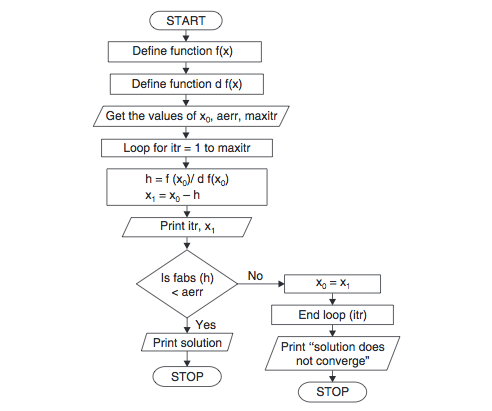Newton Raphson method, also called the Newton’s method, is the fastest and simplest approach of all methods to find the real root of a nonlinear function. It is an open bracket approach, requiring only one initial guess. This method is quite often used to improve the results obtained from other iterative approaches.
The convergence is fastest of all the root-finding methods we have discussed in Code with C. The algorithm and flowchart for Newton Raphson method given below is suitable for not only find the roots of a nonlinear equation, but the roots of algebraic and transcendental equations as well.
The overall approach of Newton’s method is more useful in case of large values the first derivative of f(X) i.e f'(X). The iterative formula for Newton Raphson method is:
[highlight color=”yellow”]Xn+1 = Xn – f(Xn)/f'(Xn)[/highlight]
Features of Newton’s Method:
- Type – open bracket
- No. of initial guesses – 1
- Convergence – quadratic
- Rate of convergence – faster
- Accuracy – good
- Programming effort – easy
- Approach – Taylor’s series
Newton Raphson Method Algorithm:
- Start
- Read x, e, n, d
*x is the initial guess
e is the absolute error i.e the desired degree of accuracy
n is for operating loop
d is for checking slope* - Do for i =1 to n in step of 2
- f = f(x)
- f1 = f'(x)
- If ( [f1] < d), then display too small slope and goto 11.
*[ ] is used as modulus sign* - x1 = x – f/f1
- If ( [(x1 – x)/x1] < e ), the display the root as x1 and goto 11.
*[ ] is used as modulus sign* - x = x1 and end loop
- Display method does not converge due to oscillation.
- Stop
Newton Raphson Method Flowchart:
These algorithm and flowchart can be used to write source code for Newton’s method in any high level programming language.
Also see,
Newton’s Method C Program
Newton’s Method MATLAB Program
Numerical Methods Tutorial Compilation
Although the Newton Raphson method is considered fast, there are some limitations. These are listed below:
- Finding the f’(x) i.e. the first derivative of f(x) can be difficult in cases where f(x) is complicated.
- When f’(xn) i.e. the first derivative of f(xn) tends to zero, Newton Raphson gives no solution.
- Infinite oscillation resulting in slow convergence near local maxima or minima.
- If the initial guess is far from the desired root, then the method may converge to some other roots. So, Newton Raphson method is quite sensitive to the starting value.
- The method cannot be applied suitably when the graph of f(x) is nearly horizontal while crossing the x-axis.
- If root jumping occurs, the intended solution is not obtained.









thanks very much
its really help me
it really helped me………..nice job (y)
thank you a lot for this code…..i kindly request you to have an explanation in a greater detail…….so that a layman can also understand please sir…………